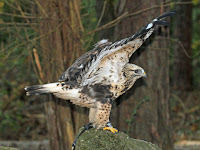ROUGH-LEGGED HAWK
ROUGH-LEGGED HAWK – (Buteo lagopus) – (See images below)
DESCRIPTION: The Rough-legged Hawk has a varied plumage that comes into two main phases, a light form and a dark form (see photo below for the latter). To further complicate matters for identification, males and females have different plumages, as well as juveniles. The bird is mainly brown on top with lighter spots. The amounts of brown vary among the morphs. Many have a large dark band across the lower chest. Some have brown streaks on the head. Some have a dark tail band. Often the wings are darker on top than under. As with other birds of prey, females are larger and heavier than males. This hawk measures about 50 cm (20 inches) long.
VOICE: https://www.xeno-canto.org/species/Buteo-lagopus
NAME: The English name ‘Rough-legged’ hawk (also called Rough-legged Buzzard) stems from the fact that its legs are covered with feathers. The bird’s Latin name ‘Buteo’ means ‘hawk’, and ‘lagopus’ means ‘hare-footed’, again referring the feather-covered legs and feet.
HABITAT: Tundra in the summer; open country on migration, such as fields and coastal areas.
DIET: Small rodents, birds, mammals or even amphibians such as frogs.
NESTING: Nests on top of cliffs or in top of trees if present. About four light blue eggs are laid. Egg numbers fluctuate with rodent population cycles. The female incubates the eggs, and also feeds the chicks from food brought by the male.
DISTRIBUTION: This hawk breeding range in the Arctic around the world. In the winter, it can be observed in most of the contiguous USA, the Atlantic provinces and southern Quebec and Ontario, and in the mid sections of Europe and Asia. Some individuals have been able to reach Hawaii as vagrants. (See note below on bird vagrancy.)
Distribution map: https://en.wikipedia.org/wiki/Rough-legged_buzzard#/media/File:Buteo_lagopus_distribution_map.png
ON PEI: The rough-legged hawk does not breed on PEI and its occurrence on the island varies depending on the seasons – occasional in the spring, accidental in the summer, and uncommon or irruptive in the fall and winter.
CONSERVATION: The population of this hawk appears stable, but it can fluctuate depending on the availability of its main prey in the Arctic, the Lemming.
NOTES: When hunting prey, the rough-legged hawk will hover above the ground.
Vagrancy: In biology this means an animal going way outside its normal range. For birds, this can happen when there are storms and they get blown off course. On other times, the bird simply wanders in a different direction than usual. Here’s an article about vagrancy in birds.
SIMILAR SPECIES: Red-tailed Hawk, Northern Harrier
REFERENCES: https://www.borealbirds.org/bird/rough-legged-hawk
http://www.oiseaux-birds.com/card-rough-legged-buzzard.html
https://en.wikipedia.org/wiki/Rough-legged_buzzard
https://hawkwatch.org/learn/factsheets/item/375-roughlegged-hawk
https://www.audubon.org/field-guide/bird/rough-legged-hawk
https://www.allaboutbirds.org/guide/Rough-legged_Hawk/id
DESCRIPTION: The Rough-legged Hawk has a varied plumage that comes into two main phases, a light form and a dark form (see photo below for the latter). To further complicate matters for identification, males and females have different plumages, as well as juveniles. The bird is mainly brown on top with lighter spots. The amounts of brown vary among the morphs. Many have a large dark band across the lower chest. Some have brown streaks on the head. Some have a dark tail band. Often the wings are darker on top than under. As with other birds of prey, females are larger and heavier than males. This hawk measures about 50 cm (20 inches) long.
VOICE: https://www.xeno-canto.org/species/Buteo-lagopus
NAME: The English name ‘Rough-legged’ hawk (also called Rough-legged Buzzard) stems from the fact that its legs are covered with feathers. The bird’s Latin name ‘Buteo’ means ‘hawk’, and ‘lagopus’ means ‘hare-footed’, again referring the feather-covered legs and feet.
HABITAT: Tundra in the summer; open country on migration, such as fields and coastal areas.
DIET: Small rodents, birds, mammals or even amphibians such as frogs.
NESTING: Nests on top of cliffs or in top of trees if present. About four light blue eggs are laid. Egg numbers fluctuate with rodent population cycles. The female incubates the eggs, and also feeds the chicks from food brought by the male.
DISTRIBUTION: This hawk breeding range in the Arctic around the world. In the winter, it can be observed in most of the contiguous USA, the Atlantic provinces and southern Quebec and Ontario, and in the mid sections of Europe and Asia. Some individuals have been able to reach Hawaii as vagrants. (See note below on bird vagrancy.)
Distribution map: https://en.wikipedia.org/wiki/Rough-legged_buzzard#/media/File:Buteo_lagopus_distribution_map.png
ON PEI: The rough-legged hawk does not breed on PEI and its occurrence on the island varies depending on the seasons – occasional in the spring, accidental in the summer, and uncommon or irruptive in the fall and winter.
CONSERVATION: The population of this hawk appears stable, but it can fluctuate depending on the availability of its main prey in the Arctic, the Lemming.
NOTES: When hunting prey, the rough-legged hawk will hover above the ground.
Vagrancy: In biology this means an animal going way outside its normal range. For birds, this can happen when there are storms and they get blown off course. On other times, the bird simply wanders in a different direction than usual. Here’s an article about vagrancy in birds.
SIMILAR SPECIES: Red-tailed Hawk, Northern Harrier
REFERENCES: https://www.borealbirds.org/bird/rough-legged-hawk
http://www.oiseaux-birds.com/card-rough-legged-buzzard.html
https://en.wikipedia.org/wiki/Rough-legged_buzzard
https://hawkwatch.org/learn/factsheets/item/375-roughlegged-hawk
https://www.audubon.org/field-guide/bird/rough-legged-hawk
https://www.allaboutbirds.org/guide/Rough-legged_Hawk/id
 |
| Rough-legged hawk, by Rob Hanson |
 |
| Rough-legged hawk, by Dick Daniels |